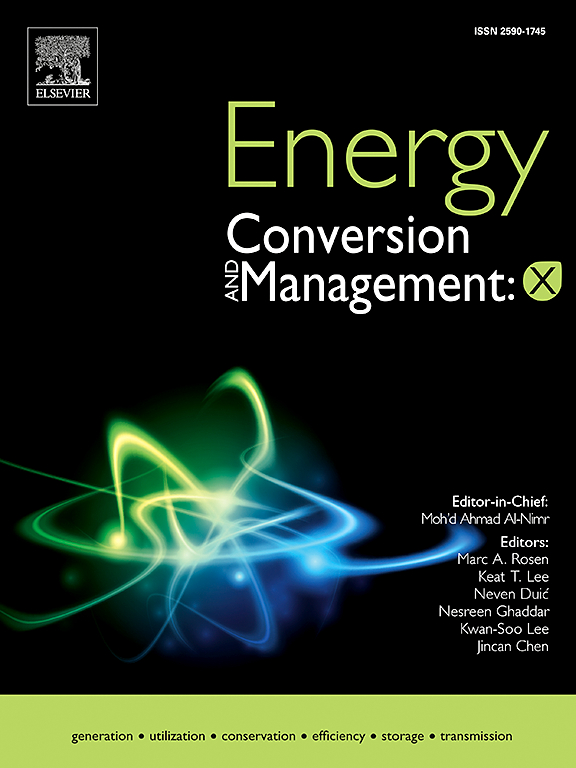优化远程海上应用的氢系统:综合分析
IF 7.1
Q1 ENERGY & FUELS
引用次数: 0
摘要
大规模储能是能源转型面临的主要挑战之一。氢被认为是一个很有前途的解决方案。本文提出了一种决策支持工具,用于优化海上应用中氢系统的规模。提出了一种制氢和储氢链的技术经济模型。混合电池被认为是平滑的间歇性,并使用分离频率的方法来完成能量管理。从技术和经济两方面对电池作为缓冲存储器的可行性进行了评价。采用非支配排序遗传算法(NSGA-II)进行双目标优化,以最小化年成本同时最大化产氢量。优化结果表明,在没有电池储能的情况下,使用接近可再生能源最大功率容量的电解槽,可获得最低的氢平准化成本(LCOH),为11.26欧元/kgH2。在这种配置下,电力成本占LCOH的48%,电解槽CAPEX占24%,油箱占22%,压缩机占6%。虽然传统上期望电池能够平滑间歇性电源并提高系统效率,但优化结果表明,它们的集成没有经济效益。提出了最优方案的技术经济分析,描述了氢气系统规模如何影响LCOH、氢气产量和其他性能指标。对关键技术经济参数对优化结果的影响进行了敏感性分析。结果表明,LCOH主要受电力成本和电解槽资本支出的影响。总体而言,最优大小显示出一致的鲁棒性。本文章由计算机程序翻译,如有差异,请以英文原文为准。
Optimizing hydrogen systems for far offshore applications: a comprehensive analysis
Large-scale energy storage is one of the major challenges facing the energy transition. Hydrogen is considered to be a promising solution. This paper proposes a decision-support tool for optimizing hydrogen system sizing in offshore applications. A techno-economic model of the hydrogen production and storage chain is proposed. A hybridization with batteries is considered to smooth the intermittences, and the energy management is done using a separation frequency method. The feasibility of using a battery as buffer storage is evaluated from both technical and economic perspectives. A bi-objective optimization using the Non-dominated Sorting Genetic Algorithm (NSGA-II) is conducted to minimize the annual cost while maximizing hydrogen production. Optimization Results show that the lowest Levelized Cost of Hydrogen (LCOH) of 11.26 €/kgH2, is obtained without battery storage using an electrolyzer size close to the maximum power capacity of the renewable source. In this configuration, electricity cost accounts for 48% of the LCOH, electrolyzer CAPEX 24%, tank 22%, and compressor 6%. Although batteries are traditionally expected to smooth intermittent power and improve system efficiency, the optimization results reveal that their integration offers no economic benefit. The presented techno economic analysis of the optimal solutions describes how the hydrogen system sizing affects the LCOH, the hydrogen production, and other performance indicators. A sensitive analysis is investigated to assess the influence of key technical and economic parameters on the optimization outcomes. The result demonstrates that LCOH is mainly driven by electricity cost and electrolyzer CAPEX. Overall, the optimal sizing showed a consistent robustness.
求助全文
通过发布文献求助,成功后即可免费获取论文全文。
去求助
来源期刊

Energy Conversion and Management-X
Multiple-
CiteScore
8.80
自引率
3.20%
发文量
180
审稿时长
58 days
期刊介绍:
Energy Conversion and Management: X is the open access extension of the reputable journal Energy Conversion and Management, serving as a platform for interdisciplinary research on a wide array of critical energy subjects. The journal is dedicated to publishing original contributions and in-depth technical review articles that present groundbreaking research on topics spanning energy generation, utilization, conversion, storage, transmission, conservation, management, and sustainability.
The scope of Energy Conversion and Management: X encompasses various forms of energy, including mechanical, thermal, nuclear, chemical, electromagnetic, magnetic, and electric energy. It addresses all known energy resources, highlighting both conventional sources like fossil fuels and nuclear power, as well as renewable resources such as solar, biomass, hydro, wind, geothermal, and ocean energy.
 求助内容:
求助内容: 应助结果提醒方式:
应助结果提醒方式:


